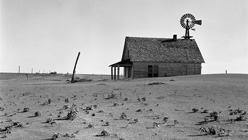Contrary to what we were taught in elementary school, history is subjective. Every chronicle, biography, textbook, and documentary about the past has a point of view. It’s an interpretation, whether it’s Robert A. Caro’s four-volume The Years of Lyndon Johnson, The Band’s four-minute The Night They Drove Old Dixie Down, or the latest fundamentalist social studies book adopted by the Texas State Board of Education.
This extends beyond the glib insight that history is written by the winners (an inconvenient truth that conservative revisionists never tire of waging guerilla warfare against), and recognizes that hindsight has many potential benefits. Alas, our track record with respect to learning from history is admittedly spotty.
My little prologue leads us to Ken Burns’ stark assertion underlying his latest immersive dive into a specific and volatile period in our nation’s checkered past, The Dust Bowl (airing Sunday, November 18 and Monday, November 19 at 8 and 10pm on KQED-Channel 9): The environmental disaster that devastated the southern Plains states in the 1930s was man-made. The three contemporary historians convened for the occasion by the filmmaker describe the opportunistic and greedy stampede to turn grasslands into wheat fields via the mechanized plowing of hundreds of thousands of acres, in a region where the wind blew hard and steady and rainfall couldn’t be counted on. The impetus? The Federal government, needing to feed the troops during World War I and seeking an incentive to boost grain production, arbitrarily increased the price of wheat.

Dorthea Lange, Woman standing outside wooden shack with two small children and baby, Tulare County, California, 1936. Courtesy of The Library of Congress.
The good times for farmers lasted all the way through the 1920s, and even after the Crash of 1929. But a drought combined with the Great Depression produced the aberration of small yields and low prices. Poverty was compounded by the nightmare of incredible (and unprecedented) dust and sand storms seemingly without end. A lot of defiant and hard-working farmers in Kansas, Oklahoma, Colorado, New Mexico, and Texas blamed the plague of storms on the continual lack of rain. Nature and/or God was responsible, they said, and took no responsibility for the large-scale adoption of misguided practices that had led to mass erosion.



